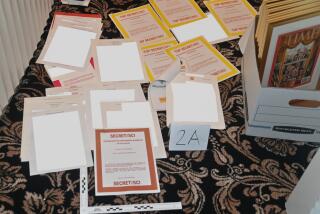Hemingway’s Hideaway Is Purely Presidential
BOSTON — Tens of thousands of documents can be found in the Ernest Hemingway Collection. The trick, however, is finding it. And don’t bother looking in Idaho, where Hemingway died in 1961.
More than 100,000 pages of his writings, 10,000 photographs and dozens of personal objects including Hemingway’s passports, flasks and wallet, are tucked into a corner on the fifth floor of the John F. Kennedy Library and Museum in Boston.
Though visitors cannot drop by to see the exhibit, they can make an appointment to go through Hemingway’s letters and manuscripts, look at his briefcase or catch a glimpse of the impala he shot.
“Just seeing his signature on a piece of scrap is amazing. It doesn’t have to be anything important,” said James Roth, a curator of the Hemingway archives.
The collection ended up in the Kennedy library through a series of events that linked the Kennedys to Hemingway’s fourth wife, Mary, who died in 1986. It’s one of only two presidential libraries believed to include material from a famous author; Herbert Hoover’s Iowa library contains the writings of Laura Ingalls Wilder, said Megan Desnoyers, another curator of the Hemingway material.
After Hemingway’s 1961 suicide, Mary wanted to return to their home in Cuba and retrieve his manuscripts and artwork. She asked a friend, who also knew the Kennedys, to help her, because the Fidel Castro-led government planned to turn the house into a Hemingway museum. Kennedy took care of it within days.
She eventually decided to donate the collection to a library. Though she contacted the New York Public Library and the Library of Congress, neither could assure her that the collection would get the attention she felt it deserved.
Then Mary Hemingway got in touch with Jacqueline Kennedy, who told her that the Hemingway collection would always have a special room at the Kennedy library.
“There was originally a concept, after President Kennedy died, that as a memorial perhaps they would have more than the traditional presidential library. They would have arts, literature, even more than that,” Desnoyers said. “That was why Mrs. Kennedy pursued this. But this turned out to be the only collection.”
Though the JFK library doesn’t advertise the Hemingway collection, many scholars consider it an incredibly valuable resource, and teachers visit it with their students.
Bruce Rettman, a high school English teacher in Northboro, Mass., said many of his students say visiting the Hemingway collection was the best field trip they ever took.
“When you show students the actual manuscripts of what they’re reading, it’s incredibly interesting to them,” Rettman said. “They see that Hemingway went through a process to create the story, that it took many revisions. They are deeply affected by that.”
More to Read
Sign up for our Book Club newsletter
Get the latest news, events and more from the Los Angeles Times Book Club, and help us get L.A. reading and talking.
You may occasionally receive promotional content from the Los Angeles Times.






